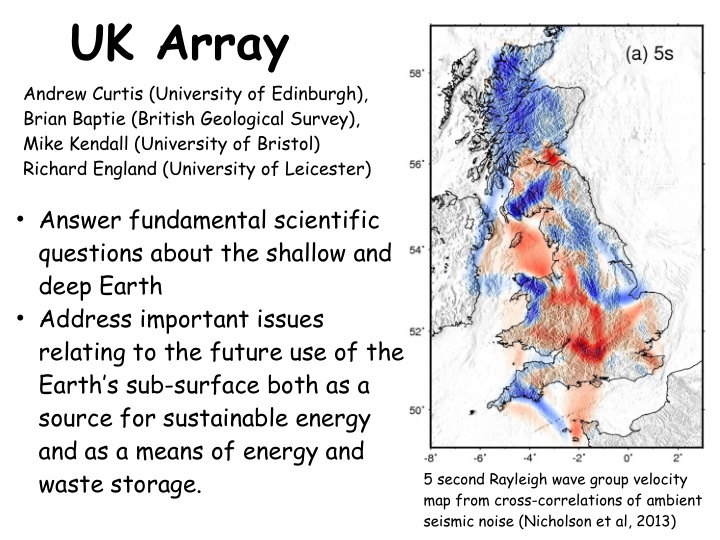



UK Array Andrew Curtis (University of Edinburgh), Brian Baptie (British Geological Survey), Mike Kendall (University of Bristol) Richard England (University of Leicester) • Answer fundamental scientific questions about the shallow and deep Earth • Address important issues relating to the future use of the Earth’s sub-surface both as a source for sustainable energy and as a means of energy and waste storage. 5 second Rayleigh wave group velocity map from cross-correlations of ambient seismic noise (Nicholson et al, 2013)
Existing Network • Cannot resolve details less than several tens of kilometres across due to the limited number of sensors • Limited ability to detect and locate small earthquakes • Difficult to attribute earthquakes to specific fault zones, and to either natural or industrial Detection capability of permanent activity. monitoring network operated by BGS in high noise conditions
5 second Rayleigh wave group velocity map (Nicholson et al, 2013) alongside: (a) simplified surface geology; and (b) areas of relative uplift and subsidence. Solid black lines in (b) represent major basin bounding faults. At short periods the maps show low velocities in Palaeozoic sedimentary basins and areas of Mesozoic subsidence. High velocity anomalies occur in areas of exposed Proterozoic basement, areas of late Palaeozoic uplift and the Ordovician volcanic centres.
Transportable Array • A transportable array of sensors that moves progressively across the UK • Fill gaps in the existing network • Spend at least 12 months in each location. • Additional stations deployed in an area of predicted future industrial activity. • In place for at least two years – before, during and after hydrocarbon exploration. The transportable array progressively covers the entire UK over a five year period
Benefits • Baseline data to enable new research into the nature and hazard of induced seismicity • Knowledge to inform the debate into benefits & hazards of industrial activities. • Effectively monitor human-induced seismicity and properly regulate subsurface production and storage. • New information about active fault systems and sub-surface stresses that can be used to identify areas of higher hazard.
Benefits • New detailed images and models of the UK's crust and upper mantle. • Unprecedented spatial resolution within the UK • Data to explore the deeper Earth and its processes. • Characterise background seismicity across the whole of the UK.
How would it work? • 40 broadband seismometers and high dynamic range data loggers • Real-time data acquisition and processing • Combine data with permanent network • Rapidly distribute to other scientists in the UK • Make available to international data centres. The transportable array progressively covers the entire UK over a five year period
Recommend
More recommend